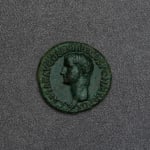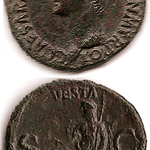Bronze Coin (Assarius) of Emperor Caligula, 37 CE - 41 CE
Bronze
10.6g
LC.010
Further images
Obverse | Lateral portrait of Emperor Caligula Inscription | C CAESAR AVG GERMANICVS PON M TR POT Reverse | Vesta seated on a throne and holding a patera and a...
Obverse | Lateral portrait of Emperor Caligula
Inscription | C CAESAR AVG GERMANICVS PON M TR POT
Reverse | Vesta seated on a throne and holding a patera and a scepter
Inscription | VESTA S C
Gaius Caesar Augustus Germanicus, also known as Caligula, was the third Emperor of the Roman Empire, reigning from 37-41 CE. He is a multifaceted historical figure who has been described in conflicting ways, with some seeing him as an irredeemable tyrant, while others see him as a ruler with a well-defined philosophy of governance. Caligula was the youngest son of Germanicus and Agrippina the Elder. He spent much of his childhood accompanying his father on military campaigns. It was here that he was nicknamed "Caligula" or "Little Army Boots" by the soldiers. Although his family suffered much persecution, the young Caligula was spared the same fate as his relatives and was instead named successor to Emperor Tiberius. Caligula sought to centralize imperial authority and demonstrated competence in managing domestic affairs, such as implementing administrative reforms. However, his contentious relationship with the Senate and his post-illness behavior ultimately led to his downfall, and his brief reign is often considered irredeemable. This assarius (AS) coin, minted during the reign of Emperor Caligula, features an obverse with the inscription "Caius CAESAR AVGustus GERMANICVS PONtifex Maximus TRibunicia POTestate". This text includes Caligula's name as well as his titles of emperor, high priest, and holder of civil authority. The reverse of the coin depicts Vesta, the goddess of the hearth fire, seated on a throne and holding a scepter and an offering cup called a patera. The inscription "ESTA Senatus Consultum" accompanies the image, indicating that the coin was issued under the authority of a decree of the Senate.
How many hands have touched a coin in your pocket or purse? What eras and lands have the coin traversed on its journey into our possession? As we reach into our pockets to pull out some change, we rarely hesitate to think of who might have touched the coin before us, or where the coin will venture to after it leaves our hands. More than money, coins are a symbol of the state that struck them, of a specific time and location, whether contemporary currencies or artifacts of a long forgotten empire. This stunning hand-struck coin reveals an expertise of craftsmanship and intricate sculptural detail that is often lacking in contemporary machine-made currencies. This ancient coin is a memorial to an emperor’s reign passed down from the hands of civilization to civilization, from generation to generation, which still appears as vibrant today as the day it was struck.
Inscription | C CAESAR AVG GERMANICVS PON M TR POT
Reverse | Vesta seated on a throne and holding a patera and a scepter
Inscription | VESTA S C
Gaius Caesar Augustus Germanicus, also known as Caligula, was the third Emperor of the Roman Empire, reigning from 37-41 CE. He is a multifaceted historical figure who has been described in conflicting ways, with some seeing him as an irredeemable tyrant, while others see him as a ruler with a well-defined philosophy of governance. Caligula was the youngest son of Germanicus and Agrippina the Elder. He spent much of his childhood accompanying his father on military campaigns. It was here that he was nicknamed "Caligula" or "Little Army Boots" by the soldiers. Although his family suffered much persecution, the young Caligula was spared the same fate as his relatives and was instead named successor to Emperor Tiberius. Caligula sought to centralize imperial authority and demonstrated competence in managing domestic affairs, such as implementing administrative reforms. However, his contentious relationship with the Senate and his post-illness behavior ultimately led to his downfall, and his brief reign is often considered irredeemable. This assarius (AS) coin, minted during the reign of Emperor Caligula, features an obverse with the inscription "Caius CAESAR AVGustus GERMANICVS PONtifex Maximus TRibunicia POTestate". This text includes Caligula's name as well as his titles of emperor, high priest, and holder of civil authority. The reverse of the coin depicts Vesta, the goddess of the hearth fire, seated on a throne and holding a scepter and an offering cup called a patera. The inscription "ESTA Senatus Consultum" accompanies the image, indicating that the coin was issued under the authority of a decree of the Senate.
How many hands have touched a coin in your pocket or purse? What eras and lands have the coin traversed on its journey into our possession? As we reach into our pockets to pull out some change, we rarely hesitate to think of who might have touched the coin before us, or where the coin will venture to after it leaves our hands. More than money, coins are a symbol of the state that struck them, of a specific time and location, whether contemporary currencies or artifacts of a long forgotten empire. This stunning hand-struck coin reveals an expertise of craftsmanship and intricate sculptural detail that is often lacking in contemporary machine-made currencies. This ancient coin is a memorial to an emperor’s reign passed down from the hands of civilization to civilization, from generation to generation, which still appears as vibrant today as the day it was struck.





